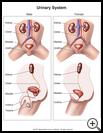
Urinary Tract Infection: Teen Version
What is a urinary tract infection?
A urinary tract infection (UTI) is an infection of the bladder and sometimes the kidneys. If the bladder is infected, it is called cystitis. If the kidneys are infected, it is called pyelonephritis. It is important to treat UTIs so that the kidneys are not damaged.
Various symptoms are possible:
- painful urination
- an urgent need to urinate
- urinating often
- daytime and nighttime wetting
- dribbling
- foul-smelling and cloudy urine
- fever
- stomachaches (especially lower abdomen)
- vomiting.
What is the cause?
Urinary tract infections are caused by bacteria. The bacteria enter the bladder by traveling up the urethra. In general, the urethra is protected, but if the opening of the urethra (or the vulva in girls) becomes irritated, bacteria can grow there. Delaying going to the bathroom makes it more likely that you will get UTIs. Sexual intercourse or careless wiping after a bowel movement might also cause irritation.
How long will it last?
With treatment, your fever should be gone and symptoms should be better by 48 hours after starting the antibiotic. The chances of getting another UTI are about 50%. Read the advice on preventing UTIs to decrease your risk.
How can I take care of myself?
- Antibiotics
You need the antibiotic prescribed by your healthcare provider. This medicine will kill the bacteria that are causing the UTI.
Try not to forget any of the doses. Take the medicine until all the pills are gone. Even though you will feel better in a few days, take the antibiotic for the full 10 days to keep the UTI from flaring up again.
- Extra fluids
Drink extra fluids to help clear the infection. Cranberry juice may be helpful.
- Fever and pain relief
Take acetaminophen (Tylenol) or ibuprofen (Advil) for the painful urination or for fever over 102°F (39°C).
- Medical follow-up
Two days after you begin antibiotics, it is important to contact your healthcare provider to find out the results of the urine culture and make sure that your infection is responding to the antibiotic.
About 1 week after antibiotic treatment is ended, return to your healthcare provider. He will probably recheck you to make sure the UTI is cured.
- Instructions for collecting a midstream, clean-catch urine specimen at home
If you are asked to bring a urine sample to your physician's office, try to collect the urine when you first urinate in the morning. Use a jar and lid that have been sterilized by boiling for 10 minutes.
For Girls: Wash the genital area several times with a clean washcloth and warm water. Sit on the toilet seat with your legs spread widely so that the labia (skin folds of the vagina) don't touch. Start to urinate into the toilet and then place the clean container directly in line with the stream of urine. Remove it after you have collected a few ounces but before you stop urinating. (The first or last drops that come out of the bladder may be contaminated with bacteria from the skin instead of the urinary tract.)
Keep the urine in the refrigerator until you take it to your provider's office. Try to keep it chilled when you bring it to the office (that is, put the jar in a plastic bag with some ice).
How can I prevent a urinary tract infection?
- Urinate at least every 3 to 4 hours during the day and don't "hold back."
- Urinate after baths.
- Sexually active young women should urinate after intercourse.
- Wipe correctly from front to back, especially after a stool.
- Don't become constipated. Try to have a BM every day.
- Drink enough fluids each day to keep the urine light-colored.
When should I call my healthcare provider?
Call IMMEDIATELY if:
- You start having back pain.
- You start feeling very sick.
Call during office hours if:
- Fever or painful urination lasts more than 48 hours after you start taking an antibiotic.
- You have other concerns or questions.
Last modified: 2011-06-07
Last reviewed: 2011-06-06

